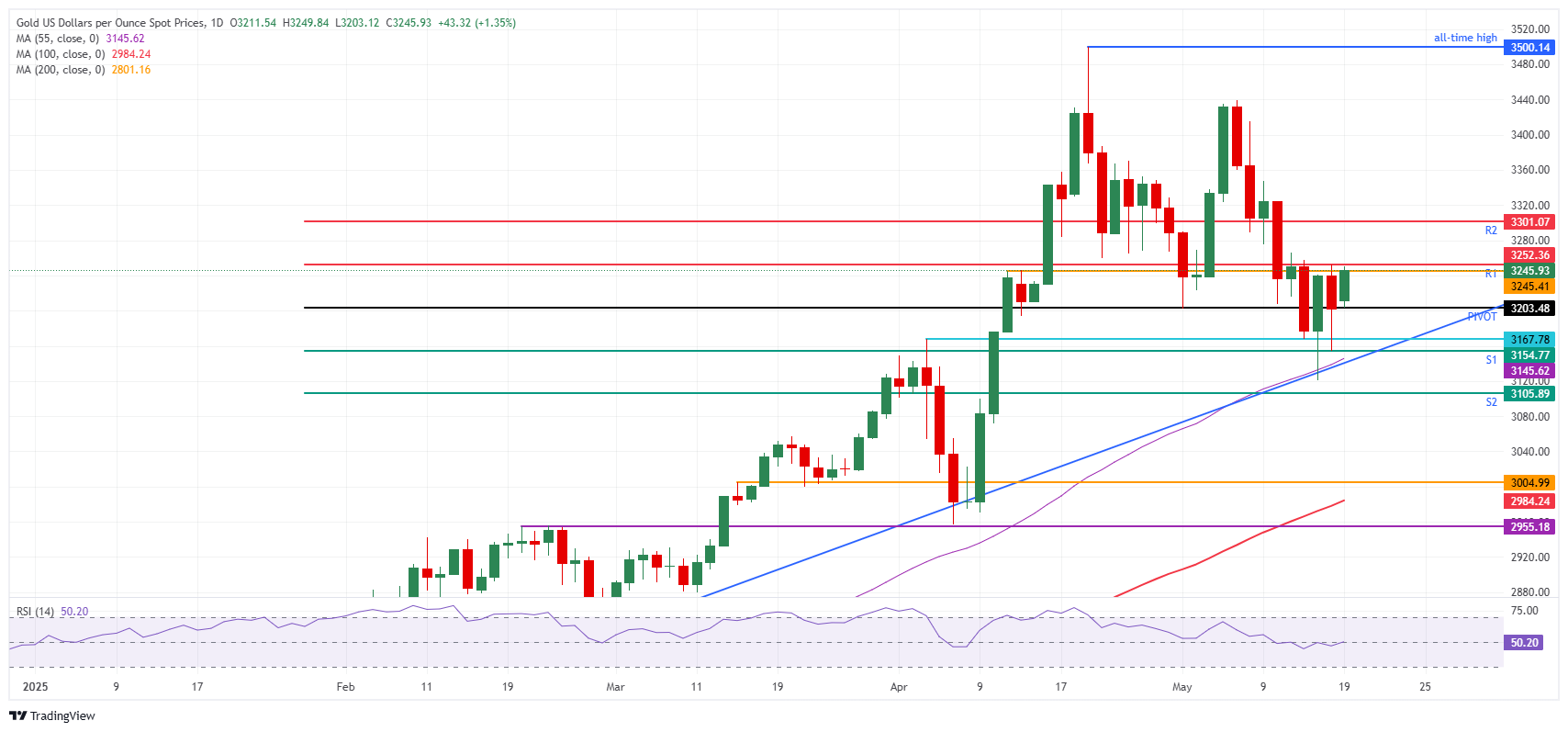Gold turns positive as Moody's US downgrade sends US yields higher
- Gold price steadies on Monday after Moody’s downgraded the US's sovereign debt credit rating on Friday, sending yields higher.
- Some headwinds are present with President Trump set to call Russian President Putin about ending the war in Ukraine.
- Gold trades in a tight range, holding above $3,230 to start the week.
Gold (XAU/USD) price remains within a tight range, trading slightly higher near $3,243 at the time of writing, with three main themes at play on Monday. Tensions are brewing in the Middle East with Israel embarking on another massive ground offensive. The military action comes just days after United States (US) President Donald Trump visited the Middle East, though he didn’t visit Israel.
The second main driver is the bond market, where several pension funds and Fixed Income (Bonds) investors will need to reshuffle their holdings after rating agency Moody’s downgraded the US's sovereign debt credit rating after the market closed on Friday. In lowering the US rating from 'AAA' to 'Aa1', Moody's noted that successive US administrations had failed to reverse ballooning deficits and interest costs, BBC reports. This could have repercussions for the Federal Reserve(Fed) and US yields, where non-US parties will ask for higher rates in search of more guarantees before considering buying US debt.
The very last driver this Monday is rather a headwind for the precious metal. US President Trump last week torpedoed peace talks in Istanbul by saying at Air Force One that no deal was possible without himself and Russian President Vladimir Putin involved. Both presidents will have a phone call on Monday to discuss the matter, and could provide headwinds for Gold if a breakthrough is materializing.
Daily digest market movers: Geopolitical, trade talks, USD to drive Gold’s price
- A reclusive Chinese billionaire whose prescient Gold trades turned into an eye-catching windfall has now become the country’s biggest Copper bull, amassing a bet worth nearly $1 billion in a market jolted by escalating competition between the US and China, Bloomberg reports.
- Gold is sliding lower as traders respond to fresh uncertainty surrounding the US outlook after Moody’s lowered the nation’s sovereign credit rating. The increase in general angst levels may also be reviving concerns about the potential for lower US and global economic growth, given the drop in crude oil contracts, Bloomberg reports.
- “While we recognize the US’ significant economic and financial strengths, we believe these no longer fully counterbalance the decline in fiscal metrics,” Moody’s added in its statement, Reuters reports.
- The US 30-year yield rose to 5% on Monday after Moody’s rate cut, back to April’s levels.
Gold Price Technical Analysis: What is next?
Did Moody’s just put a band-aid on the wound for the US? Rather, Moody’s calling out is what several traders and analysts were predicting: the US is more quickly racking up debt than it is seeing income. At one point that needs to be addressed, and President Trump might be mad at Moody’s, there is a far greater concern: the domestic activity and economy with elevated rates and the Fed having its hands tied.
On the upside, the pivotal technical level at $3,245 (April 1 high) is acting as resistance and could be difficult to reclaim. Once through there, the R1 resistance at $3,252 and the R2 resistance at $3,301 are the following levels to watch, though a major catalyst would be needed to get it there.
On the other side, the daily Pivot Point stands at $3,203, in line with the $3,200 big figure. In case that level does not hold, expect a move lower to test the support area around $3,150, with the April 3 high at $3,167 and the intraday S1 support at $3,155, before the 55-day Simple Moving Average (SMA) at $3,151.

XAU/USD: Daily Chart
Gold FAQs
Gold has played a key role in human’s history as it has been widely used as a store of value and medium of exchange. Currently, apart from its shine and usage for jewelry, the precious metal is widely seen as a safe-haven asset, meaning that it is considered a good investment during turbulent times. Gold is also widely seen as a hedge against inflation and against depreciating currencies as it doesn’t rely on any specific issuer or government.
Central banks are the biggest Gold holders. In their aim to support their currencies in turbulent times, central banks tend to diversify their reserves and buy Gold to improve the perceived strength of the economy and the currency. High Gold reserves can be a source of trust for a country’s solvency. Central banks added 1,136 tonnes of Gold worth around $70 billion to their reserves in 2022, according to data from the World Gold Council. This is the highest yearly purchase since records began. Central banks from emerging economies such as China, India and Turkey are quickly increasing their Gold reserves.
Gold has an inverse correlation with the US Dollar and US Treasuries, which are both major reserve and safe-haven assets. When the Dollar depreciates, Gold tends to rise, enabling investors and central banks to diversify their assets in turbulent times. Gold is also inversely correlated with risk assets. A rally in the stock market tends to weaken Gold price, while sell-offs in riskier markets tend to favor the precious metal.
The price can move due to a wide range of factors. Geopolitical instability or fears of a deep recession can quickly make Gold price escalate due to its safe-haven status. As a yield-less asset, Gold tends to rise with lower interest rates, while higher cost of money usually weighs down on the yellow metal. Still, most moves depend on how the US Dollar (USD) behaves as the asset is priced in dollars (XAU/USD). A strong Dollar tends to keep the price of Gold controlled, whereas a weaker Dollar is likely to push Gold prices up.

